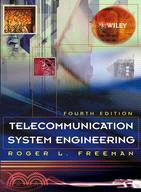Telecommunication System Engineering, Fourth Edition
商品資訊
ISBN13:9780471451334
出版社:John Wiley & Sons Inc
作者:Freeman
出版日:2004/05/28
裝訂/頁數:精裝/1024頁
規格:23.5cm*15.9cm*5.1cm (高/寬/厚)
版次:4
商品簡介
"A must for anyone in volved in the practical aspects of the telecommunications industry."-CHOICE
* Outlines the expertise essential to the successful operation and design of every type of telecommunications networks in use today
* New edition is fully revised and expanded to present authoritative coverage of the important developments that have taken place since the previous edition was published
* Includes new chapters on hot topics such as cellular radio, asynchronous transfer mode, broadband technologies, and network management
作者簡介
目次
Chapter 1: Basic Telephony.
1 Definition and Concept.
1.1 Telecommunication Networks.
2 The Simple Telephone Connection.
3 Sources and Sinks.
4 Telephone Networks: Introductory Terminology.
5 Essentials of Traffic Engineering.
5.1 Introduction and Terminology.
5.2 Measurement of Telephone Traffic.
5.3 Blockage, Lost Calls, and Grade of Service.
5.4 Availability.
5.5 “Handling” of Lost Calls.
5.6 Infinite and Finite Sources.
5.7 Probability-Distribution Curves.
5.8 Smooth, Rough, and Random Traffic.
6 Erlang and Poisson Traffic Formulas.
6.1 Alternative Traffic Formula Conventions.
6.2 Computer Programs for Traffic Calculations.
7 Waiting Systems (Queueing).
7.1 Server-Pool Traffic.
8 Dimensioning and Efficiency.
8.1 Alternative Routing.
8.2 Efficiency versus Circuit Group Size.
9 Bases of Network Configurations.
9.1 Introductory Concepts.
9.2 Higher-Order Star Network.
10 Variations in Traffic Flow.
11 One-Way and Both-Way (Two-Way) Circuits.
12 Quality of Service.
Chapter 2: Local Networks.
1 Introduction.
2 Subscriber Loop Design.
2.1 General.
2.2 Quality of a Telephone Speech Connection.
2.3 Subscriber Loop Design Techniques.
3 Current Loop Design Techniques Used in North America.
3.1 Previous Design Rules.
3.2 Current Loop Design Rules.
4 Size of an Exchange Area Based on Number of Subscribers Served.
5 Shape of a Serving Area.
6 Exchange Location.
7 Design of Local Area Analog Trunks (Junctions).
8 Voice-Frequency Repeaters.
9 Tandem Routing.
10 Dimensioning of Trunks.
11 Community of Interest.
Chapter 3 Switching in an Analog Environment.
1 Introduction.
1.1 Background and Approach.
1.2 Switching in the Telephone Network.
2 Numbering, One Basis of Switching.
3 Concentration and Expansion.
4 Basic Switching Functions.
5 Introductory Switching Concepts.
6 Electromechanical Switching.
7 Multiples and Links.
8 Definitions: Degeneration, Availability, and Grading.
8.1 Degeneration.
8.2 Availability.
8.3 Grading.
9 The Crossbar Switch.
10 System Control.
10.1 Introduction.
10.2 Interexchange Control Register.
10.3 Common Control (Hard-Wired).
11 Stored-Program Control.
11.1 Introduction.
11.2 Basic Functions of Stored-Program Control.
11.3 Evolutionary Stored Program Control and Distributed Processing.
12 Concentrators, Outside Plant Modules, Remote Switching, and Satellites.
13 Call Charging: European versus North American Approaches.
14 Transmission Factors in Switching.
14.1 Discussion.
15 Zero Test Level Point.
16 Numbering Concepts for Telephony.
16.1 Introduction.
16.2 Definitions.
16.3 Factors Affecting Numbering.
16.4 In-Dialing.
17 Telephone Traffic Measurement.
18 Dial-Service Observation.
Chapter 4: Signaling for Analog Telephone Networks.
1 Introduction.
2 Supervisory Signaling.
2.1 E and M Signaling.
3 AC Signaling.
3.1 General.
3.2 Low-Frequency AC Signaling Systems.
3.3 In-Band Signaling.
3.4 Out-of-Band Signaling.
4 Address Signaling: Introduction.
4.1 Two-Frequency Pulse Signaling.
4.2 Multifrequency Signaling.
5 Compelled Signaling.
6 Link-by-Link versus End-to-End Signaling.
7 The Effects of Numbering on Signaling.
8 Associated and Disassociated Channel Signaling.
9 Signaling in the Subscriber Loop.
9.1 Background and Purpose.
10 Metallic Trunk Signaling.
10.1 Basic Loop Signaling.
10.2 Reverse-Battery Signaling.
Chapter 5: Introduction to Transmission for Telephony.
1 Purpose and Scope.
2 The Three Basic Impairments to Voice Channel Transmission.
2.1 Attenuation Distortion.
2.2 Phase Distortion.
2.3 Noise.
2.4 Level.
2.5 Signal-to-Noise Ratio.
3 Two-Wire and Four-Wire Transmission.
3.1 Two-Wire Transmission.
3.2 Four-Wire Transmission.
3.3 Operation of a Hybrid.
3.4 Notes on the Digital Network in the Local Area.
4 Multiplexing.
4.1 Definition and Introduction.
4.2 Frequency Division Multiplex (FDM).
5 Shaping of a Voice Channel and its Meaning in Noise Measurement Units.
Chapter 6: Long-Distance Networks.
1 General.
2 The Design Problem.
3 Link Limitation.
4 International Network.
5 Exchange Location (Toll/Long-Distance Network).
5.1 Toll Areas.
6 Network Design Procedures.
7 Traffic Routing in the National Network.
7.1 Objective of Routing.
7.2 Network Topology.
7.3 Routing Scheme.
7.4 Route Selection.
7.5 Call Control Procedures.
7.6 Applications.
8 Transmission Factors in Long-Distance Telephony.
8.1 Introduction.
8.2 Definition of Echo and Singing.
8.3 Causes of Echo and Singing.
8.4 Transmission Design to Control Echo and Singing.
8.5 Introduction to Transmission-Loss Engineering.
8.6 Loss Plan for the Evolving Digital Networks (United States).
Chapter 7: The Design of Long-Distance Links.
1 Introduction.
2 The Bearer.
3 Introduction to Radio Transmission.
4 Design Essentials for Line-of-Sight Microwave Systems.
4.1 Introduction.
4.2 Setting Performance Requirements.
4.3 Site Selection and Preparation of a Path Profile.
4.4 Path Analysis or Link Budget.
4.5 Running a Path/Site Survey.
4.6 System Test Prior to Cutover.
4.7 Fades, Fading, and Fade Margins.
4.8 Diversity and Hot-Standby Operation.
4.9 LOS Microwave Repeaters.
4.10 Frequency Planning and Frequency Assignment.
5 Satellite Communications.
5.1 Introduction.
5.2 Application.
5.3 Definition.
5.4 The Satellite.
5.5 Three Basic Technical Problems.
5.6 Frequency Bands: Desirable and Available.
5.7 Multiple Access of a Satellite.
5.8 Earth Station Link Engineering.
5.9 Digital Communication by Satellite.
5.10 Very Small Aperture Terminal (VSAT) Networks.
6 Fiber-Optic Communication Links.
6.1 Scope.
6.2 Introduction to Optical Fiber as a Transmission Medium.
6.3 Types of Optical Fiber.
6.4 Splices and Connectors.
6.5 Light Sources.
6.6 Light Detectors.
6.7 Optical Fiber Amplifiers.
6.8 Fiber-Optic Link Design.
6.9 Wavelength-Division Multiplexing (WDM).
Chapter 8: Digital Transmission Systems.
1 Digital versus Analog Transmission.
2 Basis of Pulse-Code Modulation.
3 Development of a Pulse-Code Modulation Signal.
3.1 Sampling.
3.2 Quantization.
3.3 Coding.
4 Pulse-Code Modulation System Operation.
5 Practical Applications.
5.1 General.
6 PCM Line Codes.
7 Regenerative Repeaters.
8 Signal-to-Gaussian-Noise Ratio on Pulse-Code Modulation Repeated Lines.
9 PCM System Enhancements.
9.1 North American DS1.
9.2 Enhancements to E1.
10 Higher-Order PCM Multiplex Systems.
10.1 Introduction.
10.2 Stuffing and Justification.
10.3 North American Higher-Level Multiplex.
10.4 The European E1 Digital Hierarchy.
11 Long-Distance PCM Transmission.
11.1 Transmission Limitations.
11.2 Jitter.
11.3 Distortion.
11.4 Thermal Noise.
11.5 Crosstalk.
11.6 Echo.
12 Digital Loop Carrier.
13 SONET and SDH.
13.1 Introduction.
13.2 SONET.
13.3 Synchronous Digital Hierarchy (SDH).
14 Summary of Advantages and Disadvantages of Digital Transmission.
Chapter 9: Digital Switching and Networks.
1 Introduction.
1.1 Radical New Directions.
2 Advantages and Issues of PCM Switching When Compared to Its Analog Counterpart.
3 Approaches to PCM Switching.
3.1 General.
3.2 Time Switch.
3.3 Space Switch.
3.4 Time–Space–Time Switch.
3.5 Space–Time–Space Switch.
3.6 TST Compared to STS.
4 Digital Switching Concepts—Background.
4.1 Early Implementations.
4.2 Higher-Level Multiplex Structures Internal to a Digital Switch.
4.3 Remote Switching Capabilities.
4.4 Digital Cross-Connects.
4.5 A New Direction—Programmable Switching.
5 The Digital Network.
5.1 Introduction.
5.2 Digital Extension to the Subscriber.
5.3 Change of Profile of Services.
5.4 Digital Transmission Network Models—ITU-T Organization (CCITT).
5.5 Digital Network Synchronization.
5.6 Digital Network Performance Requirements.
5.7 A-Law Conversion to µ-Law; Digital Loss.
Chapter 10: Introduction to Data Communications.
1 Overview.
2 The Bit.
3 Removing Ambiguity—Binary Convention.
4 Coding.
4.1 Introduction to Binary Coding Techniques.
4.2 Specific Binary Codes for Information Interchange.
5 Errors in Data Transmission.
5.1 Introduction.
5.2 Throughput.
5.3 The Nature of Errors.
5.4 Error Detection and Error Correction.
5.5 Forward-Acting Error Correction (FEC).
5.6 Error Correction with Feedback Channel.
6 The DC Nature of Data Transmission.
6.1 Loops.
6.2 Neutral and Polar DC Transmission Systems.
7 Binary Transmission and the Concept of Time.
7.1 Introduction.
7.2 Asynchronous and Synchronous Transmission.
7.3 Timing.
7.4 Distortion.
7.5 Bits, Bauds, and Symbols.
7.6 Digital Data Waveforms.
8 Data Interface—The Physical Layer.
8.1 TIA/EIA-644 Low-Voltage Differential Signaling (LVDS).
9 Digital Transmission on an Analog Channel.
9.1 Introduction.
9.2 Modulation–Demodulation Schemes.
9.3 Critical Parameters.
9.4 Channel Capacity.
9.5 Equalization.
9.6 Data Transmission on the Digital Network.
Chapter 11: Data Networks and their Operation.
1 Introduction.
1.1 Applications.
2 Initial Design Considerations.
2.1 General.
2.2 Data Terminals, Workstations, PCs, and Servers.
3 Network Topologies and Configurations.
4 Overview of Data Switching.
4.1 Introduction.
4.2 Traffic Engineering—A Modified Meaning.
4.3 Packet Networks and Packet Switching.
4.4 Interior Gateway Routing Protocol (IGRP).
5 Circuit Optimization.
5.1 Throughput from Another Perspective.
5.2 Cost-Effective Options to Meet “Throughput” Requirements.
6 Data Network Operation.
6.1 Introduction.
6.2 Protocols.
6.3 X.25: A Packet-Switched Network Access Standard.
7 TCP/IP and Related Protocols.
7.1 Background and Scope.
7.2 TCP/IP and Data-Link Layers.
7.3 The IP Routing Function.
7.4 The Transmission Control Protocol (TCP).
7.5 Brief Overview of Internet Protocol Version 6 (IPV6).
8 Multiprotocol Label Switching (MPLS).
8.1 Overview.
8.2 Acronyms and Definitions.
8.3 MPLS Description.
8.4 Notes on FEC.
9 Virtual Private Networks (VPNs).
9.1 Why VPNs?
9.2 Two Major Requirements.
9.3 Specialized VPN Internet Protocols.
9.4 Principal Components of a VPN Based on the Internet.
Chapter 12: Voice-Over IP.
1 Data Transmission Versus Conventional Telephony.
2 Drawbacks and Challenges for Transmitting Voice on Data Packets.
3 VoIP, Introductory Technical Description.
3.1 VoIP Gateway.
3.2 An IP Packet as Used for VoIP.
3.3 The Delay Trade-off.
3.4 Lost Packet Rate.
3.5 Echo and Echo Control.
4 Media Gateway Controller and its Protocols.
4.1 Overview of the ITU-T Rec. H.323 Standard.
4.2 Session Initiation Protocol (SIP).
4.3 Media Gateway Control Protocol (MGCP).
4.4 Megaco or ITU-T Rec. H.248 [13].
Chapter 13: Local Area Networks.
1 Definition and Applications.
2 LAN Topologies.
3 The Two Broad Categories of LAN Transmission Techniques.
3.1 Broadband Transmission Considerations.
3.2 Fiber-Optic LANs.
4 Overview of IEEE/ANSI LAN Protocols.
4.1 General.
4.2 How LAN Protocols Relate to OSI.
4.3 Logical Link Control (LLC).
5 LAN Access Protocols.
5.1 Introduction.
5.2 Background: Contention and Polling.
5.3 CSMA and CSMA/CD Access Techniques.
5.4 Token Bus.
5.5 Token Ring.
5.6 Fiber Distributed Data Interface.
5.7 LAN Performance.
5.8 LAN Internetworking via Spanning Devices.
5.9 Switching Hubs.
6 Wireless LANs (WLANs).
6.1 The Different 802.11 Standards Issued as of March 2002.
Chapter 14: Integrated Services Digital Networks.
1 Background and Goals of Integrated Services Digital Network (ISDN).
2 ISDN Structures.
2.1 ISDN User Channels.
2.2 Basic and Primary User Interfaces.
3 User Access and Interface.
3.1 General.
4 ISDN Protocols and Protocol Issues.
5 ISDN Networks.
6 ISDN Protocol Structures.
6.1 ISDN and OSI.
6.2 Layer 1 Interface, Basic Rate.
6.3 Layer 1 Interface, Primary Rate.
7 Layer 2 Interface: Link Access Procedure for the D-Channel.
7.1 Layer 2 Frame Structure for Peer-to-Peer Communication.
7.2 LAPD Primitives.
8 Overview of Layer 3.
8.1 Layer 3 Specification.
Chapter 15: Speeding Things Up with Frame Relay.
1 Introduction.
2 How Can the Network Be Speeded Up?
2.1 Background and Rationale.
2.2 The Genesis of Frame Relay.
2.3 Introduction to Frame Relay.
2.4 The Frame Structure.
2.5 DL-CORE Parameters (As Defined by ANSI).
2.6 Procedures.
2.7 Traffic and Billing on Frame Relay.
2.8 Congestion Control.
2.9 Policing a Frame Relay Network.
2.10 Quality of Service Parameters.
3 Frame Relay Standards.
3.1 ANSI T1.618.
3.2 ANSI T1.617.
3.3 ANSI LMI.
3.4 Manufacturers’ LMI.
3.5 Frame Relay NNI PVC.
3.6 FRF.3.
3.7 FRF.4 UNI SVC.
3.8 FRF.10 NNI SVC.
3.9 FRF.11.
3.10 Frame Relay Fragmentation Implementation Agreement, FRF.12.
3.11 Timeplex (BRE2).
3.12 Cascade.
3.13 LAPF.
3.14 Multiprotocol over Frame Relay (Based on RFC 1490 and RFC 2427).
Chapter 16: The Asynchronous Transfer Mode (ATM) and Broadband ISDN.
1 Where are We Going?
2 Introduction to ATM.
3 User–Network Interface (UNI) Configuration and Architecture.
4 The ATM Cell—Key to Operation.
4.1 ATM Cell Structure.
4.2 Idle Cells.
5 Cell Delineation and Scrambling.
5.1 Delineation and Scrambling Objectives.
5.2 Cell Delineation Algorithm.
6 ATM Layering and B-ISDN.
6.1 Functions of Individual ATM/B-ISDN Layers.
7 Services: Connection-Oriented and Connectionless.
7.1 Functional Architecture.
7.2 CLNAP Protocol Data Unit (PDU) and Encoding.
7.3 ATM Classes of Service.
8 Aspects of a B-ISDTM Network.
8.1 ATM Routing and Switching.
9 Signaling Requirements.
9.1 Setup and Release of VCCs.
9.2 Signaling Virtual Channels.
9.3 Meta-Signaling.
10 Quality of Service (QoS).
10.1 ATM Service Quality Review.
10.2 QoS Parameter Descriptions.
11 Traffic Control and Congestion Control.
11.1 Generic Functions.
11.2 Events, Actions, Time Scales, and Response.
11.3 Quality of Service, Network Performance, and Cell Loss Priority.
11.4 Traffic Descriptors and Parameters.
11.5 User–Network Traffic Contract.
12 Transporting ATM Cells.
12.1 In the DS3 Frame.
12.2 DS1 Mapping.
12.3 E1 Mapping.
12.4 Mapping ATM Cells into SDH.
12.5 Mapping ATM Cells into SONET.
Chapter 17: CCITT Signaling System No. 7.
1 Introduction.
2 Overview of SS No. 7 Architecture.
3 SS No. 7 Relationship to OSI.
4 Signaling System Structure.
4.1 Signaling Network Management.
5 The Signaling Data Link (Layer 1).
6 The Signaling Link (Level 2).
6.1 Basic Signal Unit Format.
7 Signaling Network Functions and Messages (Layer 3).
7.1 Introduction.
7.2 Signaling Message-Handling Functions.
7.3 Signaling Network Management.
8 Signaling Network Structure.
8.1 Introduction.
8.2 International and National Signaling Networks.
9 Signaling Performance—Message Transfer Part.
9.1 Basic Performance Parameters.
9.2 Traffic Characteristics.
9.3 Transmission Parameters.
9.4 Signaling Link Delays over Terrestrial and Satellite Links.
10 Numbering Plan for International Signaling Point Codes.
11 Hypothetical Signaling Reference Connections.
12 Signaling Connection Control Part (SCCP).
12.1 Introduction.
12.2 Services Provided by the SCCP.
12.3 Peer-to-Peer Communication.
12.4 Primitives and Parameters.
12.5 Connection-Oriented Functions: Temporary Signaling Connections.
12.6 SCCP Formats and Codes.
13 User Parts.
13.1 Introduction.
13.2 Telephone User Part (TUP).
13.3 ISDN User Part (ISUP).
14 SS7 Signaling Data Connectivity over the Internet.
14.1 New IP Transport Protocol.
14.2 Stream Control Transport Protocol (SCTP).
14.3 Message Format of SCTP.
Chapter 18: Wireless and Cellular/Mobile Radio.
1 Introduction.
1.1 Background.
1.2 Scope and Objective.
2 Basic Concepts of Cellular Radio.
3 Personal Communication Systems.
3.1 Defining Personal Communications.
4 Radio Propagation in the Mobile/PCS Environment.
4.1 The Propagation Problem.
4.2 Several Propagation Models.
4.3 Microcell Prediction Model According to Lee.
5 Impairments—Fading in the Mobile Environment.
5.1 Introduction.
5.2 Classification of Fading.
5.3 Diversity—A Technique to Mitigate the Effects of Fading and Dispersion.
5.4 Cellular Radio Path Calculations.
6 The Cellular Radio Bandwidth Dilemma.
6.1 Background and Objectives.
6.2 Bit Rate Reduction of the Digital Voice Channel.
7 Network Access Methods.
7.1 Introduction.
7.2 Frequency Division Multiple Access (FDMA).
7.3 Time Division Multiple Access (TDMA).
7.4 Code Division Multiple Access (CDMA).
8 Frequency Reuse.
9 Paging Systems.
9.1 What Are Paging Systems?
9.2 Radio-Frequency Bands for Pagers.
9.3 Radio Propagation into Buildings.
9.4 Techniques Available for Multiple Transmitter Zones.
9.5 Paging Receivers.
9.6 System Capacity.
9.7 Codes and Formats for Paging Systems.
9.8 Considerations for Selecting Codes and Formats.
10 Mobile Satellite Communications.
10.1 Background and Scope.
10.2 How MSS Operates.
10.3 Safety Systems Associated with Mobile Platforms.
10.4 Operational or Near-Term Planned MSS Systems.
10.5 Advantages and Disadvantages of a Low Earth Orbit.
11 1G, 2G, 2-1/2G, And 3G, That Is the Question.
11.1 Second Generation (2G).
11.2 Evolution from 2G to 3G.
12 Universal Mobile Telecommunications System (UMTS).
12.1 Introduction.
12.2 Architecture of a UMTS Network.
12.3 Changes and Requirements for UMTS Phase 1.
12.4 UMTS Network Elements.
13 Wireless Access Protocol (WAP).
13.1 Wireless Markup Language (WML) and WAP Proxy.
13.2 Stability Issues.
Chapter 19: Last-Mile Broadband Connectivity and Wireless Local Loop (WLL).
1 Background and Chapter Objective.
2 Conventional Wire Pair in the Last Mile.
3 Wire Pair Equipped with DSL Modems.
3.1 Asymmetric Digital Subscriber Line (ADSL).
3.2 High-Bit-Rate Digital Subscriber Line (HDSL).
3.3 Rate-Adaptive DSL (RADSL).
3.4 Very High Rate DSL (VDSL).
3.5 The DSLAM (Digital Subscriber Line Access Multiplexer).
4 Digital Loop Carrier (DLC).
5 Broadband Microwave/Millimeter Wave Last-Mile Transmission.
5.1 Multichannel Multipoint Distribution Service (MMDS).
5.2 Local Multipoint Distribution System (LMDS).
6 CATV as a Basic Transport Medium for the Last Mile.
Chapter 20: Optical Networking.
1 Background and Chapter Objective.
2 New Optical Technologies Required.
2.1 Derived Technology Applications.
3 Distributed Switching.
4 Overlay Networks.
4.1 Two-Layer Networks are Emerging.
5 Optical Switching.
5.1 MEMS Switching.
6 A Practical Optical Add–Drop Multiplexer.
6.1 OXCs and OADMs Enhance Availability and Survivability.
7 Improvements in the Management of the New Network Architecture.
8 All-Optical Cross-Connects.
9 Options for Optical Layer Signaling.
10 Four Classes of Optical Networks.
10.1 Generic Networks.
11 Optical Bidirectional Line-Switched Rings.
12 Overview of Generalized Multiprotocol Label Switching (GMPLS).
12.1 Introduction.
12.2 Selected GMPLS Terminology.
12.3 The GMPLS Protocol Suite.
12.4 GMPLS Switching Based on Diverse Formats.
12.5 Bundling Links.
13 Standardization of Optical Control Plane Protocols.
13.1 GMPLS and ASON Differ.
13.2 Hierarchical Routing in Optical Networks.
14 Summary.
Chapter 21: Network Management.
1 What is Network Management?
2 The Bigger Picture.
3 Traditional Breakout by Tasks.
3.1 Fault Management.
3.2 Configuration Management.
3.3 Performance Management.
3.4 Security Management.
3.5 Accounting Management.
4 Survivability—Where Network Management Really Pays.
4.1 Survivability Enhancement—Rapid Troubleshooting.
5 System Depth—a Network Management Problem.
5.1 Aids in Network Management Provisioning.
5.2 Communications Channels for the Network Management System.
6 Network Management from a PSTN Perspective.
6.1 Objectives and Functions.
6.2 Network Traffic Management Center.
6.3 Network Traffic Management Principles.
6.4 Network Traffic Management Functions.
6.5 Network Traffic Management Controls.
7 Network Management Systems in Enterprise Networks.
7.1 What are Network Management Systems?
7.2 Introduction to Network Management Protocols.
7.3 Remote Monitoring (RMON).
7.4 SNMP Version 2.
7.5 SNMP Version 3.
7.6 Common Management Information Protocol (CMIP).
8 Telecommunication Management Network (TMN).
9 Network Management in ATM.
9.1 Interim Local Management Interface (ILMI) Functions.
9.2 ILMI Service Interface.
Appendix 1: Acronyms and Abbreviations.
Index.
主題書展
更多書展本週66折
您曾經瀏覽過的商品
購物須知
外文書商品之書封,為出版社提供之樣本。實際出貨商品,以出版社所提供之現有版本為主。部份書籍,因出版社供應狀況特殊,匯率將依實際狀況做調整。
無庫存之商品,在您完成訂單程序之後,將以空運的方式為你下單調貨。為了縮短等待的時間,建議您將外文書與其他商品分開下單,以獲得最快的取貨速度,平均調貨時間為1~2個月。
為了保護您的權益,「三民網路書店」提供會員七日商品鑑賞期(收到商品為起始日)。
若要辦理退貨,請在商品鑑賞期內寄回,且商品必須是全新狀態與完整包裝(商品、附件、發票、隨貨贈品等)否則恕不接受退貨。






















